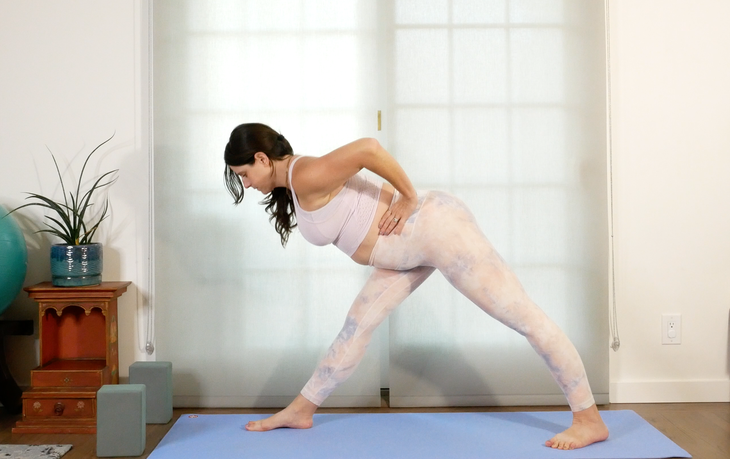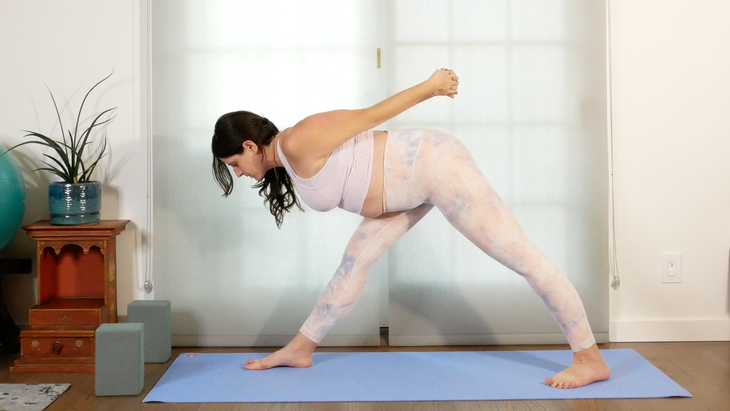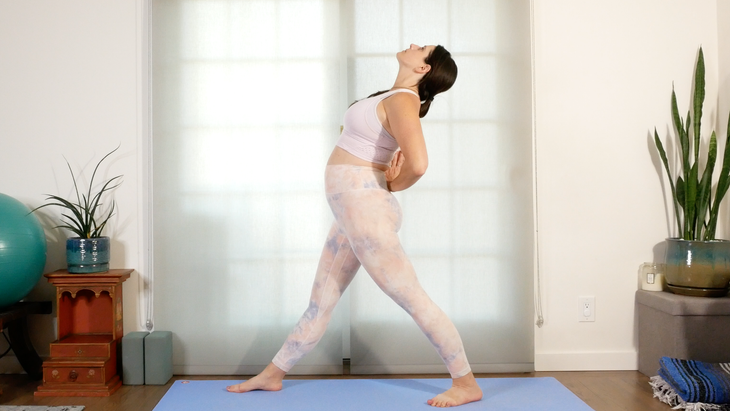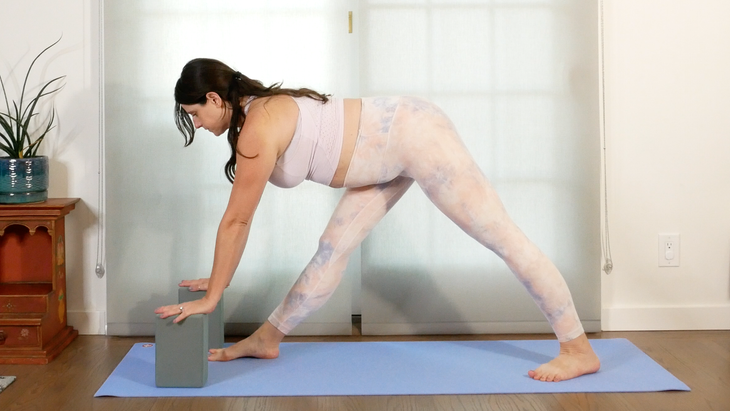Pārśvottānāsana has many different interpretations, from the physical expression of the posture to what yoga teachers name it. For example, you’ll often hear two different English translations of the Sanskrit term. When you break down the word, you see that in the literal translation “parsva” means side, “ut” means intense, and “tan,” means to stretch, or Intense Side Stretch. Other teachers refer to it as Pyramid Pose.
Many interpretations means many benefits
In the most commonly taught shape of Parsvottanasana, you take your hands behind your back in Pascimanamaskar (Reverse Prayer). This encourages a backbend and keeps your spine from rounding as you bend forward at the hip joint. When you practice this traditional arm position, the pose can be a backbend and a heart opener. Of course, there are times when heart-opening may not be appropriate. When your heart is broken, for example, it can be helpful to do postures that are more rounded or folded inward, which allows the pieces of your heart to be mended back together.
There are additional variations of Parsvottanasana that allow you to discover whatever interpretation of the pose you need at any given time.
7 variations of Parsvottanasana
Getting Parsvottanasana
Stand at the top of your mat and place your hands on your hips. Step your left foot back 3-4 feet, maintaining hip-width distance between your feet. Turn your left foot and hip forward enough that you feel stable, and your pelvis is working toward a neutral rotation, meaning your hip bones are facing the front of your mat. Now choose among the arm options and upper-body positions you see below. To come out of the pose, lift your torso upright and step your back foot up to meet your front foot. Repeat each pose on the second side.
Hands in Reverse Prayer
This reverse prayer shape can be complicated if you have any restrictions in your shoulders. This pose offers lots of options to achieve the same effect. If you are able to bring your hands into reverse prayer easily, it can be an excellent way to open up your chest and shoulders, as well as your wrists and forearms. Those areas tend to get tight from using the smart phones, computers, and other devices we all rely on.

Hands on Hips
The traditional variation is not accessible for all bodies. Furthermore, there are many days where you may not want to work so hard. Keeping your hands on your hips allows you to focus on opening your chest without being distracted by the complexity of the work in the shoulder joint of reverse prayer.

Interlaced Hands
Similarly, interlacing your hands behind your back can be an alternative to reverse prayer. This position of the hands also allows for a lot of variability. For example, if your shoulders are more mobile, you can practice squeezing your palms together. Conversely, if your shoulders are on the tighter side or you are dealing with injury, open your hands so that the heels of your hands are further apart. Alternatively , you can hold a strap behind your back, as wide as you need to, and achieve chest-opening.

Upright Backbend
While I’m an enormous fan of practicing a backbend while folded forward, there are also lots of benefits to staying upright in your torso. First, it is an excellent way to prepare for deeper backbends. It’s also helpful if folding is contraindicated for any reason, such as pregnancy or eye injuries. And there is something quite freeing about leaning back and going with gravity, when you normally have to fight against it in this pose. You can use any of the hand variations above when exploring being upright.

Hands on Blocks
Backbending isn’t the only goal of Pārśvottānāsana. It could be argued that the forward-bending element is equally important. It’s half the pose, after all. Forward bends lengthen the entire back side of your body, which include your calves, hamstrings, and spine. You can get creative with where you place your blocks, too. Placing your blocks toward the back of the mat can help you fold more deeply. Walk your blocks farther forward for more length. You can also position your hands directly underneath your shoulders and keep your torso at the same height of your pelvis.

Holding a Block Behind Your Back:
If you want to gain strength in your arms while creating space in the shoulders, try squeezing a block behind your back. With your fingers interlaced or your hands in reverse prayer, there is a temptation to rely on your flexibility, which can mean overstretching at your joints without engaging the necessary stabilizing muscles. Because the arms are squeezing in toward one another when holding a block, it fires up the muscles of the outer arms, including your triceps and deltoids.

Hands on Seat of Chair:
Many people prefer not to let their head fall lower than their heart for a variety of reasons including eye injuries, unregulated blood pressure, vertigo, or migraines. Having our hands on the seat of a chair keeps your torso at the same height as your hips. It is still technically a forward fold, in that you’re bending at your hips, but when your torso is elevated, it doesn’t cause the same kind of pressure in your head. This is also simply an excellent variation to encourage length.

